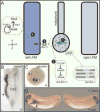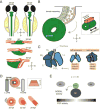Left-Right Patterning: Breaking Symmetry to Asymmetric Morphogenesis
- PMID: 28720483
- PMCID: PMC5764106
- DOI: 10.1016/j.tig.2017.06.004
Left-Right Patterning: Breaking Symmetry to Asymmetric Morphogenesis
Abstract
Vertebrates exhibit striking left-right (L-R) asymmetries in the structure and position of the internal organs. Symmetry is broken by motile cilia-generated asymmetric fluid flow, resulting in a signaling cascade - the Nodal-Pitx2 pathway - being robustly established within mesodermal tissue on the left side only. This pathway impinges upon various organ primordia to instruct their side-specific development. Recently, progress has been made in understanding both the breaking of embryonic L-R symmetry and how the Nodal-Pitx2 pathway controls lateralized cell differentiation, migration, and other aspects of cell behavior, as well as tissue-level mechanisms, that drive asymmetries in organ formation. Proper execution of asymmetric organogenesis is critical to health, making furthering our understanding of L-R development an important concern.
Keywords: Nodal; Pitx2; cell migration; cilia; left–right asymmetry; morphogenesis.
Copyright © 2017 Elsevier Ltd. All rights reserved.
Figures




References
-
- Shiraishi I, Ichikawa H. Human heterotaxy syndrome - from molecular genetics to clinical features, management, and prognosis. Circulation journal : official journal of the Japanese Circulation Society. 2012;76:2066–2075. - PubMed
-
- Kennedy MP, Omran H, Leigh MW, Dell S, Morgan L, Molina PL, Robinson BV, Minnix SL, Olbrich H, Severin T, et al. Congenital heart disease and other heterotaxic defects in a large cohort of patients with primary ciliary dyskinesia. Circulation. 2007;115:2814–2821. - PubMed
-
- Shiratori H, Hamada H. TGFbeta signaling in establishing left-right asymmetry. Seminars in cell & developmental biology. 2014;32:80–84. - PubMed
Publication types
MeSH terms
Grants and funding
LinkOut - more resources
Full Text Sources
Other Literature Sources

